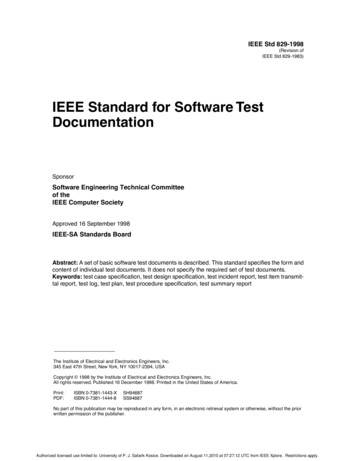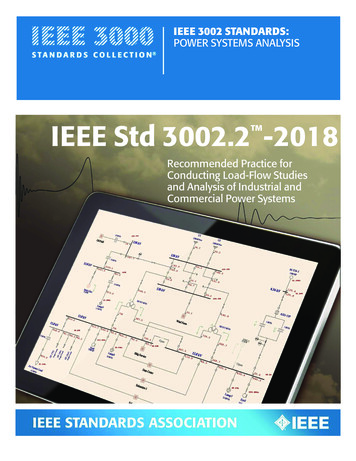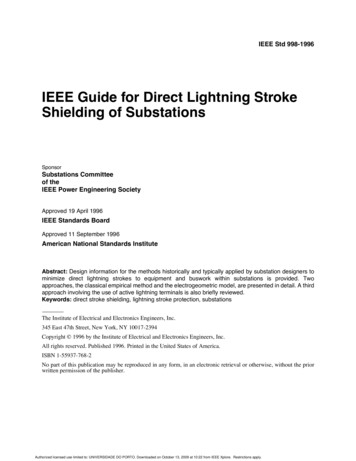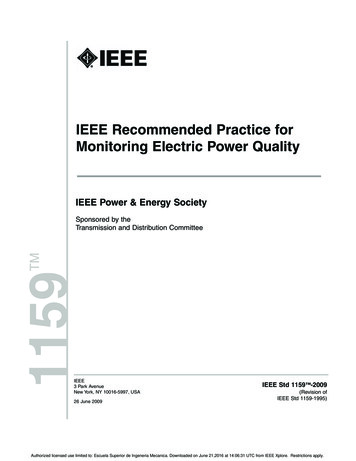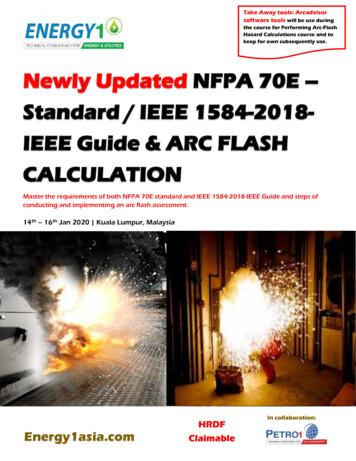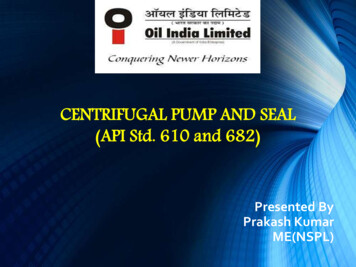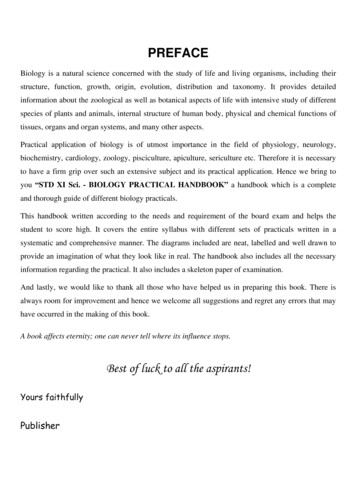
Transcription
IEEE Guide for Measuring EarthResistivity, Ground Impedance,and Earth Surface Potentials of aGrounding SystemIEEE Power and Energy SocietySponsored by theSubstations CommitteeIEEE3 Park AvenueNew York, NY 10016-5997USAIEEE Std 81 -2012(Revision ofIEEE Std 81-1983)28 December 2012Authorized licensed use limited to: Australian National University. Downloaded on July 27,2018 at 14:57:43 UTC from IEEE Xplore. Restrictions apply.
Authorized licensed use limited to: Australian National University. Downloaded on July 27,2018 at 14:57:43 UTC from IEEE Xplore. Restrictions apply.
IEEE Std 81TM-2012(Revision ofIEEE Std 81-1983)IEEE Guide for Measuring EarthResistivity, Ground Impedance,and Earth Surface Potentials of aGrounding SystemSponsorSubstations Committeeof theIEEE Power and Energy SocietyApproved 5 December 2012IEEE-SA Standards BoardApproved 3 October 2014American National Standards InstituteAuthorized licensed use limited to: Australian National University. Downloaded on July 27,2018 at 14:57:43 UTC from IEEE Xplore. Restrictions apply.
Abstract: Practical test methods and techniques are presented for measuring the electricalcharacteristics of grounding systems. Topics addressed include safety considerations, measuringearth resistivity, measuring the power system frequency resistance or impedance of the groundsystem to remote earth, measuring the transient or surge impedance of the ground system toremote earth, measuring step and touch voltages, verifying the integrity of the grounding system,reviewing common methods for performing ground testing, reviewing instrumentationcharacteristics and limitations, and reviewing various factors that can distort test measurements.Keywords: electrical measurements, ground impedance, ground potential rise, groundresistance, ground testing, IEEE 81TM, remote earth, soil resistivity The Institute of Electrical and Electronics Engineers, Inc.3 Park Avenue, New York, NY 10016-5997, USACopyright 2012 by the Institute of Electrical and Electronics Engineers, Inc.All rights reserved. Published 28 December 2012. Printed in the United States of America.National Electrical Safety Code and NESC are registered trademarks in the U.S. Patent & Trademark Office, owned by The Institute ofElectrical and Electronics Engineers, Incorporated.IEEE is a registered trademark in the U.S. Patent & Trademark Office, owned by the Institute of Electrical and ElectronicsEngineers, Incorporated.PDF:Print:ISBN 978-0-7381-8028-1ISBN 978-0-7381-8031-1STD98028STDPD98028IEEE prohibits discrimination, harassment and bullying. For more information, visit -26.html.No part of this publication may be reproduced in any form, in an electronic retrieval system or otherwise, without the prior written permissionof the publisher.Authorized licensed use limited to: Australian National University. Downloaded on July 27,2018 at 14:57:43 UTC from IEEE Xplore. Restrictions apply.
Notice and Disclaimer of Liability Concerning the Use of IEEE Documents: IEEE Standards documents are developedwithin the IEEE Societies and the Standards Coordinating Committees of the IEEE Standards Association (IEEE-SA)Standards Board. IEEE develops its standards through a consensus development process, approved by the American NationalStandards Institute, which brings together volunteers representing varied viewpoints and interests to achieve the final product.Volunteers are not necessarily members of the Institute and serve without compensation. While IEEE administers the processand establishes rules to promote fairness in the consensus development process, IEEE does not independently evaluate, test, orverify the accuracy of any of the information or the soundness of any judgments contained in its standards.Use of an IEEE Standard is wholly voluntary. IEEE disclaims liability for any personal injury, property or other damage, ofany nature whatsoever, whether special, indirect, consequential, or compensatory, directly or indirectly resulting from thepublication, use of, or reliance upon any IEEE Standard document.IEEE does not warrant or represent the accuracy or content of the material contained in its standards, and expressly disclaimsany express or implied warranty, including any implied warranty of merchantability or fitness for a specific purpose, or thatthe use of the material contained in its standards is free from patent infringement. IEEE Standards documents are supplied "ASIS."The existence of an IEEE Standard does not imply that there are no other ways to produce, test, measure, purchase, market, orprovide other goods and services related to the scope of the IEEE standard. Furthermore, the viewpoint expressed at the time astandard is approved and issued is subject to change brought about through developments in the state of the art and commentsreceived from users of the standard. Every IEEE standard is subjected to review at least every ten years. When a document ismore than ten years old and has not undergone a revision process, it is reasonable to conclude that its contents, although still ofsome value, do not wholly reflect the present state of the art. Users are cautioned to check to determine that they have thelatest edition of any IEEE standard.In publishing and making its standards available, IEEE is not suggesting or rendering professional or other services for, or onbehalf of, any person or entity. Nor is IEEE undertaking to perform any duty owed by any other person or entity to another.Any person utilizing any IEEE Standards document, should rely upon his or her own independent judgment in the exercise ofreasonable care in any given circumstances or, as appropriate, seek the advice of a competent professional in determining theappropriateness of a given IEEE standard.Translations: The IEEE consensus development process involves the review of documents in English only. In the event thatan IEEE standard is translated, only the English version published by IEEE should be considered the approved IEEE standard.Official Statements: A statement, written or oral, that is not processed in accordance with the IEEE-SA Standards BoardOperations Manual shall not be considered the official position of IEEE or any of its committees and shall not be considered tobe, nor be relied upon as, a formal position of IEEE. At lectures, symposia, seminars, or educational courses, an individualpresenting information on IEEE standards shall make it clear that his or her views should be considered the personal views ofthat individual rather than the formal position of IEEE.Comments on Standards: Comments for revision of IEEE Standards documents are welcome from any interested party,regardless of membership affiliation with IEEE. However, IEEE does not provide consulting information or advice pertainingto IEEE Standards documents. Suggestions for changes in documents should be in the form of a proposed change of text,together with appropriate supporting comments. Since IEEE standards represent a consensus of concerned interests, it isimportant to ensure that any responses to comments and questions also receive the concurrence of a balance of interests. Forthis reason, IEEE and the members of its societies and Standards Coordinating Committees are not able to provide an instantresponse to comments or questions except in those cases where the matter has previously been addressed. Any person whowould like to participate in evaluating comments or revisions to an IEEE standard is welcome to join the relevant IEEEworking group at http://standards.ieee.org/develop/wg/.Comments on standards should be submitted to the following address:Secretary, IEEE-SA Standards Board445 Hoes LanePiscataway, NJ 08854-4141USAPhotocopies: Authorization to photocopy portions of any individual standard for internal or personal use is granted by TheInstitute of Electrical and Electronics Engineers, Inc., provided that the appropriate fee is paid to Copyright Clearance Center.To arrange for payment of licensing fee, please contact Copyright Clearance Center, Customer Service, 222 Rosewood Drive,Danvers, MA 01923 USA; 1 978 750 8400. Permission to photocopy portions of any individual standard for educationalclassroom use can also be obtained through the Copyright Clearance Center.Authorized licensed use limited to: Australian National University. Downloaded on July 27,2018 at 14:57:43 UTC from IEEE Xplore. Restrictions apply.
Notice to usersLaws and regulationsUsers of IEEE Standards documents should consult all applicable laws and regulations. Compliance withthe provisions of any IEEE Standards document does not imply compliance to any applicable regulatoryrequirements. Implementers of the standard are responsible for observing or referring to the applicableregulatory requirements. IEEE does not, by the publication of its standards, intend to urge action that is notin compliance with applicable laws, and these documents may not be construed as doing so.CopyrightsThis document is copyrighted by the IEEE. It is made available for a wide variety of both public andprivate uses. These include both use, by reference, in laws and regulations, and use in private selfregulation, standardization, and the promotion of engineering practices and methods. By making thisdocument available for use and adoption by public authorities and private users, the IEEE does not waiveany rights in copyright to this document.Updating of IEEE documentsUsers of IEEE Standards documents should be aware that these documents may be superseded at any timeby the issuance of new editions or may be amended from time to time through the issuance of amendments,corrigenda, or errata. An official IEEE document at any point in time consists of the current edition of thedocument together with any amendments, corrigenda, or errata then in effect. In order to determine whethera given document is the current edition and whether it has been amended through the issuance ofamendments, corrigenda, or errata, visit the IEEE-SA Website at http://standards.ieee.org/index.html orcontact the IEEE at the address listed previously. For more information about the IEEE StandardsAssociation or the IEEE standards development process, visit the IEEE-SA Website a, if any, for this and all other standards can be accessed at the following x.html. Users are encouraged to check this URL for errataperiodically.ivCopyright 2012 IEEE. All rights reserved.Authorized licensed use limited to: Australian National University. Downloaded on July 27,2018 at 14:57:43 UTC from IEEE Xplore. Restrictions apply.
PatentsAttention is called to the possibility that implementation of this standard may require use of subject mattercovered by patent rights. By publication of this standard, no position is taken by the IEEE with respect tothe existence or validity of any patent rights in connection therewith. If a patent holder or patent applicanthas filed a statement of assurance via an Accepted Letter of Assurance, then the statement is listed on theIEEE-SA Website s.html. Letters of Assurance mayindicate whether the Submitter is willing or unwilling to grant licenses under patent rights withoutcompensation or under reasonable rates, with reasonable terms and conditions that are demonstrably free ofany unfair discrimination to applicants desiring to obtain such licenses.Essential Patent Claims may exist for which a Letter of Assurance has not been received. The IEEE is notresponsible for identifying Essential Patent Claims for which a license may be required, for conductinginquiries into the legal validity or scope of Patents Claims, or determining whether any licensing terms orconditions provided in connection with submission of a Letter of Assurance, if any, or in any licensingagreements are reasonable or non-discriminatory. Users of this standard are expressly advised thatdetermination of the validity of any patent rights, and the risk of infringement of such rights, is entirelytheir own responsibility. Further information may be obtained from the IEEE Standards Association.vCopyright 2012 IEEE. All rights reserved.Authorized licensed use limited to: Australian National University. Downloaded on July 27,2018 at 14:57:43 UTC from IEEE Xplore. Restrictions apply.
ParticipantsAt the time this guide was submitted to the IEEE-SA Standards Board for approval, the Measuring EarthResistivity, Ground Impedance, and Earth Surface Potentials of a Grounding System Working Group hadthe following membership:Dennis DeCosta, ChairRobert Brown, Vice ChairWilliam Sheh, SecretaryHanna AbdallahStan ArnotThomas BarnesBryan BeskeDale BolingSteven BrownK. S. ChanKoushik ChandaE. Peter DickMarcia EblenGary EngmannD. Lane GarrettSteven GreenfieldMartin HavelkaJeffrey JowettRichard KeilDave KelleyDonald LairdHenri LemeilleurAllen LoveSakis MeliopoulosMike NooriRobert NowellShashi PatelJesse RorabaughHamid SharifniaDouglas SmithCurtis StidhamBrian StoryAlexander WongThe following members of the individual balloting committee voted on this guide. Balloters may havevoted for approval, disapproval, or abstention.Hanna AbdallahWilliam AckermanMichael AdamsAli Al AwaziStan ArnotMichael BaldwinThomas BarnesRobert BarnettG. BartokEarle Bascom IIIGeorge BeckerW. J. (Bill) BergmanBryan BeskeSteven BeznerWallace BinderDale BolingDieter BraunJeffrey BrittonDerek BrownSteven BrownWilliam BushMark BushnellWilliam ByrdThomas CallsenMichael ChampagneKoushik ChandaRobert ChristmanRandy ClellandBryan ColeJerry CorkranAlireza DaneshpooyGlenn DavisDennis DeCostaGary DonnerDouglas DorrDonald DunnMarcia EblenMichael EddsGary EngmannBrian ErgaC. ErvenRabiz FodaMarcel FortinFredric FriendD. Lane GarrettGeorge GelaFrank GerleveDavid GiegelDavid GilmerJalal GohariEdwin GoodwinJames GrahamJoseph Grav
IEEE Guide for Measuring Earth Resistivity, Ground Impedance, and Earth Surface Potentials of a Grounding System Sponsored by the Substations Committee IEEE 3 Park Avenue New York, NY 10016-5997 USA 28 December 2012 IEEE Power and Energy Society IEEE Std 81 -2012 (Revision of IEEE Std 81-1983) Authorized licensed use limited to: Australian National University. Downloaded on July


